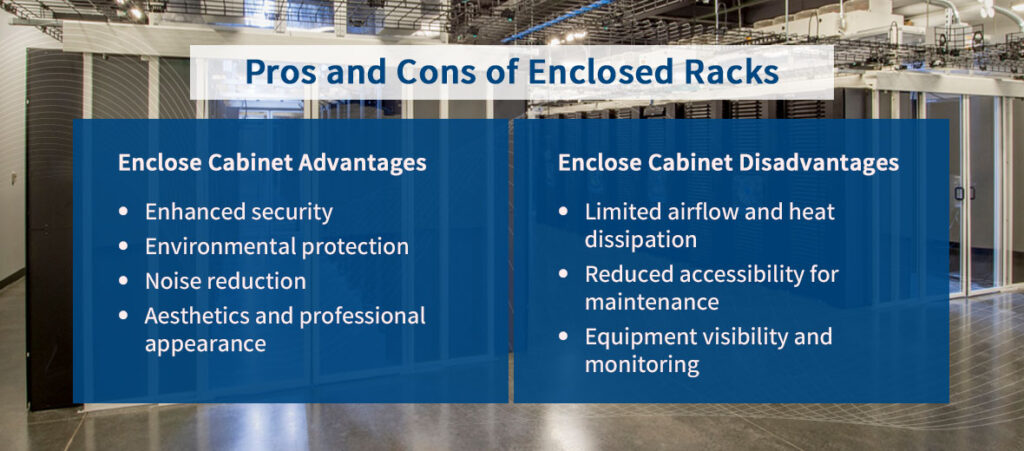Enclosed Rack vs. Open-Frame Rack
When mounting audio and IT hardware, selecting the correct rack can often become a perplexing task. Among the various rack types available, two prevalent options are open-frame racks and enclosed cabinets. While there isn’t a one-size-fits-all answer to determine which rack is the best, we’re here to shed light and do an open-frame and enclosed rack comparison of both types, starting with the open-frame.
Pros and Cons of Open-Frame Racks
Open-frame racks have been a staple in data centers and IT environments for years. They are designed with a simple and exposed structure, offering several advantages that appeal to IT professionals.
Open-Frame Advantages
There are several benefits of open-frame racks, resulting in popularity among IT professionals for mounting audio and IT hardware. Understanding the pros of open-frame racks will help you assess whether they fit your needs:
- Cost-effective: Open-frame racks generally have a more budget-friendly cost than enclosed cabinets. If you’re managing a tight budget or must deploy multiple racks, open-frame options provide a cost-efficient solution without compromising functionality.
- Accessibility and airflow: Open-frame racks provide unobstructed airflow around your equipment. The enhanced ventilation helps prevent overheating, ensuring your sensitive IT components run optimally. Additionally, the open design facilitates easy access to equipment from all sides, making maintenance and cable management more straightforward.
- Adaptability and scalability: IT environments are often dynamic, with changing hardware needs and technologies. Open-frame racks are designed to accommodate various equipment sizes and form factors.
- Visibility and cable management: Open-frame racks make visualizing your equipment easier. This advantage allows for better cable management, making identifying and addressing any potential issues or connectivity concerns simpler.
Open-Frame Disadvantages
While open-frame racks offer several advantages, they do come with potential drawbacks:
- Security concerns: One drawback of open-frame racks is their lack of physical security. Additional security measures must be implemented to safeguard your assets when dealing with sensitive data or valuable equipment.
- Dust and debris: The open design of these racks makes them susceptible to dust and debris accumulation, potentially impacting equipment performance and longevity. Regular cleaning and maintenance are necessary to keep your hardware in top condition.
- Noise and aesthetics: Open-frame racks might generate more noise than enclosed cabinets due to less sound insulation. Additionally, their exposed appearance might only suit some environments, particularly in settings where aesthetics play a significant role.
Open-Frame Applications
Open-frame racks find their niche in various IT environments, offering specific advantages that make them well-suited for certain scenarios. Let’s explore some of the applications where open-frame racks are suitable.
1. Data Centers and Server Rooms
In large-scale data centers or server rooms, where airflow management and accessibility are paramount, open-frame racks are highly valuable. Their open design allows for airflow around densely packed equipment, helping dissipate heat efficiently.
2. Telecom and Network Infrastructure
Telecommunication companies and network service providers often rely on open-frame racks for infrastructure needs. These racks offer easy access to network switches, patch panels, and other networking components, making installation, maintenance and cable management more convenient. The open design also facilitates rapid deployment and enables technicians to troubleshoot network issues efficiently.
3. Audio-Visual (AV) Installations
The exposed structure of open-frame racks simplifies cable routing and management, making it easier to connect and organize various AV components like audio mixers, video switchers, amplifiers, and media servers. Additionally, the enhanced airflow helps prevent AV equipment from overheating, ensuring uninterrupted operation during critical presentations or events.
4. Test Labs and Research Facilities
Open-frame racks offer flexibility and adaptability, making them suitable for test labs and research facilities. As new technologies and experiments are introduced, these environments often require frequent equipment changes and reconfigurations. The open-frame allows for easy customization and scalability, accommodating different types and sizes of test equipment and instruments. The accessible design also facilitates quick equipment setup and repositioning, saving valuable time in research and testing processes.

Pros and Cons of Enclosed Racks
Enclosed rack cabinets, also known as closed cabinets, offer a different approach to housing audio and IT hardware than open-frame racks. These cabinets provide a secure and enclosed environment but also have advantages and potential drawbacks.
Enclose Cabinet Advantages
Enclosed cabinets provide a secure and protected environment for audio and IT hardware. The pros include:
- Enhanced security: The primary advantage of enclosed cabinets is their heightened security level. Enclosed cabinets offer physical protection with their locked doors and solid panels. The security makes them particularly suitable for environments where data security and asset protection are top priorities.
- Environmental protection: Enclosed cabinets better protect against external factors such as dust, humidity, and water.
- Noise reduction: The enclosed design of cabinets can be especially advantageous in settings where noise reduction is needed for maintaining a productive and comfortable working environment.
- Aesthetics and professional appearance: Enclosed cabinets offer a sleek and professional appearance, making them suitable for environments where aesthetics matter. The closed panels hide cables and equipment, giving the space a tidy and organized look.
Enclose Rack Disadvantages
With their many advantages, enclosed cabinets also have specific considerations that IT professionals should keep in mind:
- Limited airflow and heat dissipation: The enclosed nature of cabinets restricts airflow around the equipment, potentially leading to heat buildup. Ensure adequate cooling mechanisms, such as fans or cooling systems, are in place when using enclosed cabinets.
- Reduced accessibility for maintenance: Unlike open-frame racks that provide easy access from all sides, enclosed cabinets may present challenges regarding equipment maintenance and cable management.
- Equipment visibility and monitoring: The closed panels of cabinets limit the visibility and monitoring of equipment. It may be more challenging to inspect devices or identify potential issues at a glance visually.
Enclosed Rack Applications
Enclosed cabinets are used in various IT environments where equipment security, environmental control, and aesthetics are required.
1. Enterprise IT Infrastructure
Enclosed cabinets offer a comprehensive solution for large enterprises and organizations managing their extensive IT infrastructure. The enclosed cabinets protect against the environment, safeguarding critical equipment. Lockable doors provide an additional layer of security, ensuring that only authorized personnel can access the equipment.
2. Security and Surveillance Systems
Enclosed cabinets are often utilized in security and surveillance systems to house equipment such as video recorders, network switches, and power supplies. The lockable doors prevent unauthorized access, ensuring the surveillance system’s integrity and reliability.
3. Medical and Healthcare Facilities
In medical and health care facilities, enclosed cabinets provide a protective environment for IT infrastructure supporting operations. Enclosed cabinets ensure the integrity, security, and availability of vital health care systems, from housing servers and network equipment that store and manage patient data to securely storing medical imaging devices.
Other Rack Considerations
Beyond the choice between enclosed cabinets and open-frame racks, several additional factors warrant consideration when selecting the correct rack solution for your audio and IT hardware:
- Rack size and capacity: Assess your equipment’s size and capacity requirements. Consider the dimensions and weight of the devices you plan to mount in the rack, ensuring the chosen solution can accommodate them comfortably.
- Cooling and ventilation: Evaluate the airflow capabilities of the rack solution you’re considering. Proper cooling and ventilation help maintain your equipment’s optimal performance and longevity. Look for features such as built-in fans, cable management options, and airflow management accessories to promote efficient heat dissipation and prevent equipment overheating.
- Cable management: Efficient cable management maintains a tidy and organized IT environment. Look for options such as cable trays, routing channels, and cable management panels that help keep cables organized.

Partner With Reliable Manufacturer, Emcor
In this process, you should partner with a reputable provider who can meet your diverse needs and offer customized solutions. Emcor, a trusted metal cabinets and racks manufacturer, stands out in the market. We understand that one size does not fit all in electronic equipment enclosures, and we excel at processing unique requests and offering modifications to standard products.
You can have confidence in the quality, functionality, and customization options available for your rack solutions. As you navigate selecting the right rack solution, contact Emcor to consult, service, and supply the products that meet your specific requirements.